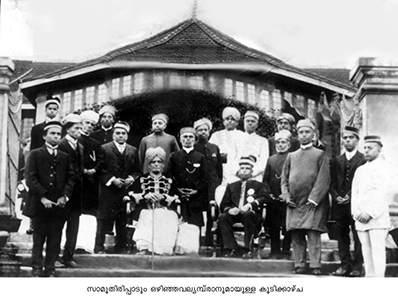.jpg)
Raja Rama Varma
He was only 43 years old when the installation as Raja took place in October of 1895. He was the son of Kunjikavu Thampuran of Thavazhy three and Kudalattu Namboodiri. He was a hands on Raja and made frequent visits to Madras in the first few years. In 1897, he was made the Knight Commander of the Order of Star of India. In 1900, the State was honored by the visit of Lord Curzon, His Excellency the Viceroy. Two years later, the Raja visited northern India and participated in the Coronation Durbar at Delhi. He was at this time invested with the Insignia of the Knight Grand Commander of the Order of the Star of India. The next year he visited the Southern India and culminated by visiting the Raja of Travancore. In 1906, he visited their Royal Highnesses Prince and Princesses of Wales in Madras and later received a return visit from them. The seventeen gun salute was raised to nineteen gun salute in honor of this exalted ruler.
The most important progress that took place during Raja Rama Varma’s reign was the introduction of rail link from Shornnur to Ernakulam. Though this has been thought about and planned for the last 25 years it took Dewan Rajagopalachari to come up with the scheme with total support from the British Resident Nicholson. The large reserve fund in the treasury was another impetus. In 1899 Government of India agreed. Initially the Madras Railway Company projected a cost of 50 lakhs. Considering the number of difficult bridges to be built the amount was revised to 58 lakhs. The line was opened for goods traffic in June and passenger traffic in July 1902. The actual booked capital had already exceeded 70 lakhs. The net return on the capital outlay was a meager 2 percent. By 1907, the Cochin Durbar worked out a favorable plan with the South Indian Railway Company which returned 3.9 percent in 1909.
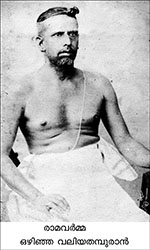
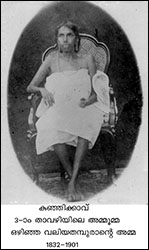
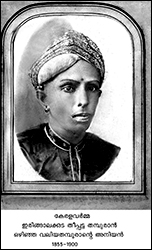

From left - Raja Rama Varma; His mother Kunjikavu from Thavazhy 3; His younger brother at young age; His younger brother older and in native attire.
The Cochin State Forest Tramway was another infrastructural venture that was completed during the reign of Raja Rama Varma. (Great detail is provided by
Devan R.Varma with David Churchill & Mark Reusser in their monograph published in 2005). Forest lands had been mismanaged and destroyed without any vision or supervision for a long time. Some sensible reforms were implemented only by John Munro in 1814. Later decades also witnessed destruction of vast tracts of forest lands. In 1895, it was Sir James Thompson who gave the idea to the Raja about better management of the forest with the help of a tramway system. Raja’s chief adviser was Alvar Chetty. The construction commenced in 1901, inaugurated by the Madras Governor Sir Arthur Ampthill. In 1907, the Raja passed the Cochin Forest Tramway Act. The expenditure came to 24.17 lakhs including maintenance when the project was finished in 1910. In the first few years 17 – 18 lakhs of rupees worth of forest products were generated and transported.
Further improvement in medical and public health areas occurred during the Raja’s time. The fledgling lunatic asylum in Thrissur and an in-house facility for leprosy patients in Venduruthy Island got enhanced funding and support. A full-fledged department of Sanitation was organized under the Chief medical officer. Progressive ideas of keeping vital statistics, keeping birth and death registers, census, and official record of the Cochin State in a manual form were great achievements under this ruler.
He wanted to develop classical Sanskrit and he had a great supporter in British Resident Hannyngton in the 1890’s. Though the Raja initially funded and managed the Sanskrit Patasala the State took over and the institution thrived. Many of the Princes and the Princesses received elementary education through this school. The institution did great things during his life time and after and continues to be so.
His conservative approach though served him well amongst the status quo conservative subjects, the newly evolving progressives were critical about several issues.
Raja Rama Varma wrote a confidential letter in 1899. (IOR R/2/900/391) In 1853, there were 23 members of the Royal Family. An allowance of one lakh rupees was used for the expense of the Royal Family. Additionally income from private properties could be utilized. In 1899, the Family had grown greatly in number and this was a great concern for the Raja. Dewan Rajagopalachari worked out a scheme which would enhance the income of the Royal Family to 3.5 lakhs.
Raja wanted very much to stand on traditions and conventions. There was a group in the Royal Family motivated by progressive and liberal ideas. Raja’s own brother ( pictured above ) was the leader of this group. One of his ardent followers was Kerala Varma , who was destined to be a Raja at a later date. IOR:R/2/880/59 is illustrative of various issues involving the young educated Princes and Englishmen trying to work within the policies prevalent at that time. The Nineth Prince wanted to work and be useful. He had earned a B.A degree and felt amply qualified. He even suggested that he would gladly become a commoner if his allowance for the next several years was paid to him cumulatively so that he could go into business for himself and not be a Prince in waiting at all.
Raja’s own diary shows:-“Influence of English education on my cousins and nephews had created an erroneous impression about personal freedom and freedom of expression. They also wanted to impose these ideas on others as their duty. This mental calculation fell flat on the majority of citizens ignorant of these new thinking except creating an aversion. My brother had a coterie of newly earned B.A. degree holders of the Royal Family for support. My brother who had sufficient knowledge in Sanskrit and intellectual capacity had a tendency to jump into conclusions and decisions rather precipitously. I tried to dissuade him from this many times. Instead of heeding to my advice he argued with me and tried to influence my thinking to suit his beliefs. When that failed we split forever. He tried to oppose me in many ways. I opposed him with equal vigor and ultimately we lost our love for each other. This has been the most painful experience in my life. From childhood, we have always been together in thought and action. In the end it was lost forever.” This brother died at Irinjalakuda while he was the Elaya Raja.
In 1902, the Governor of Madras visited the State. Strict protocols were to be followed by all for such an occassion. At Cochin he was to stay at the Residency located on an island to which he was to come by boat. Afterwards the Raja was expected to come across from the main land to the Residency to pay a State visit. Since the Shornnur-Cochin railway opened, the Governor would have initially come by train and the Raja was to meet the Governor at the Ernakulam platform. Initially Raja refused to do this because there was no such precedent. Later the Raja wrote to the Resident Mackenzie “I have come to understand that according to a ruling of the Government of India I am expected to receive the Governor at the railway station when he comes to the capital of my State, and I now write to say that I shall be glad to do so.”…..IOR R/2/900/395
There has been a myth or rumor floating around even up to this day that the Raja pawned or sold several gold nettipattams belonging to the Poornathrayeesa temple to finance the railway project. As Melkoima of the temple, he had the authority to invest private property for the general good. So far no official records have indicated that this was done. No Devaswom Ola or papers have been discovered to substantiate this.
In 1913, the Raja wrote a private letter to the Viceroy Baron Hardinge asking a favor on behalf of his nephew Kerala Varma for possible placement in the Indian Financial Department. He had addressed him as ‘My esteemed friend’. This was challenged as lacking in decorum and respect, which naturally annoyed the Raja who was himself a stickler for etiquette. The raja had been advised in the past by the private Secretary of the Viceroy as to how to address the Viceroy which was ‘my esteemed friend’!
Another episode was narrated by the grand-daughter of the Raja years later. All the Princes were awaiting the Viceroy Lord Curzon in Delhi at the great Durbar. But the Viceroy was unusually late and Raja decided to leave the Durbar Hall much against the Travancore Raja’s advice. It appears that just when the Raja was exiting he ran into Lord Curzon, who asked the Raja what he would have done if his wife would have had an accident falling from a horse on that particular day. Raja followed Curzon when the latter made a gallant entry into the Durbar and apologized profusely for being late.
Raja Rama Vurmah wrote a confidential letter to Mr. Andrew from Hill Bungalow on the 18th August of 1905. He had arrived at a point that he was considering retirement. “I wish to be relieved of my charge of the administration at the end of this Malabar year. My chief and almost sole reason for deciding on such a course is my desire to have complete rest and peace of mind during the remaining portion of my life.” He felt he had fulfilled many reforms in 11 years, and the only unfinished job was the revenue settlement issue. He felt that this will be done in the next 3 or 4 years by the efficient Dewan given a free hand. He felt that he needed to give enough early notice to the Madras Government.
He expected certain benefits when he leaves the administration. He was to have a personal allowance as considered appropriate by the Durbar. He would appreciate if the Durbar will consider hundred rupees a month to be given to his wife and children even after his death even though it will be a precedent. “Another point about which I should like to make a proposal is that a separate home may be built for my residence after my retirement and after my time the same may become the property of my wife and her children. I shall be very glad if this request can be favorably considered.”
Report of the Administration of Cochin 1914 gave the following relevant information.
1. An extraordinary issue of the Government Gazette, dated 8th December 1913 intimated the desire of the Raja to retire into private life. “
MY BELOVED SUBJECTS,
This announcement I am now going to make will, I am sure, cause you surprise and grief, but hoping you will bear with me and extend to me your sympathy, I now convey to you my wish, owing to advancing age, to retire into private life, and my intention to give effect to the same as soon as I have concluded the few important measures undertaken by me which, I am hoping, I shall be able to do before long. I hope to bid farewell tom you at a Public Durbar the date of which will, in due course, be announced by my Dewan.
(Signed) RAMA VURMAH”
2. In November 1913, His Highness the Raja went on a tour to Madras and stayed for three weeks at his residence in Tullochs Gardens. He visited His Excellency the Governor of Madras and later met His Excellency Lord Hardinge, Viceroy and Governor General of India.
3. An event of historical interest was the visit of Zamorin of Calicut as a guest of the State. In the picture below, Zamorin is on the left, and the Raja on the right, surrounded by senior members of the Cochin Family.
4. Mr. A.T.Forbes I.C.S continued as the British Resident and Mr.A.R.Banerji continued as Dewan.
5. The Financial Review indicated a glaring fact. In 1909 the State had a net liability of Rs 15,77,128. By 1914 a surplus of Rs 12,02,271was accomplished.
6. The important regulations that were passed included Cochin Municipal and Sanitary Improvement, Cochin Motor Vehicles regulation, the Cochin Village Panchayat Regulation.
7. Amongst several bills under consideration the Tenancy bill reviewed by a special committee was published in the Gazette for criticism. The bill was under the consideration of the Madras Government when the Year closed.
The Cochin Royal Family Historical Society held annual seminars on various periods of Cochin History at the Kalikotta Palace, Tripunithura . The seminar held in 2003, discussed the Reign of Rama Varma, the Abdicated Highness.
Click here for video of seminar 2003, part 1
J.W Bhore - The Dewan of Cochin
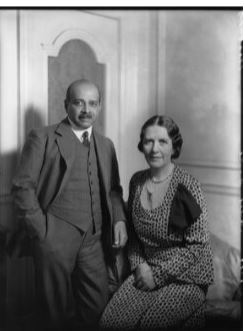
Sir Joseph W Bhore and Lady Margaret Bhore
After the abdication of the Raja of Cochin, Mr. Bhore continued in the same post and served the successor Raja Rama Varma. Relations with the new Ruler were not very cordial and Mr Bhore left the post in 1919.
After leaving Cochin, he served in different positions in the Indian Civil Service. His wife was a Scottish physician missionary. He retired with a knighthood in 1935 to the Island of Guernsey. But during World War II, the Germans occupied that Island and the Bhores returned to India.
He is best remembered for his chairmanship of the Health Survey and Development Committee set up to study health conditions and health organizations in British India. Later in 1952, based on that report, Government of India established the first Primary health centres. One such early center was started by nuns of the Nazareth order which later became sisters of Charity.
Based on that report, Govt of India set up the first Indian Institute of of Medical Sciences; and replaced the LMP degree with MBBS degree.
Sir Joseph W Bhore moved back to Guernsey where he died in 1960.
.jpg)




